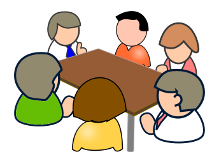 Group meetings have a reputation for being notoriously inefficient. We’ve all been in meetings that last hours but don’t seem to accomplish much. Inefficient group meetings don’t have to be a fact of business life, there are steps that can be taken to make meetings more effective. Stephen Robbins and Phillip Hunsaker, authors of Training in Interpersonal Skills, describe 12 steps that can help improve how group meetings are conducted. We’ve outlined them for you in this article.
Group meetings have a reputation for being notoriously inefficient. We’ve all been in meetings that last hours but don’t seem to accomplish much. Inefficient group meetings don’t have to be a fact of business life, there are steps that can be taken to make meetings more effective. Stephen Robbins and Phillip Hunsaker, authors of Training in Interpersonal Skills, describe 12 steps that can help improve how group meetings are conducted. We’ve outlined them for you in this article.
When you’re responsible for running a group meeting, follow these steps:
- Prepare a meeting agenda. The agenda defines the meeting’s purpose (and ensures that the meeting actually has a purpose) as well as what you hope for it to accomplish. It should list who will attend and what, if any, preparation is required from those who will attend. Don’t force people who don’t really need to be there sit through a long meeting. If an update is enough, send them one via email after the meeting. The agenda should also list in detail what is to be covered and indicate a specific start and ending time.
- Distribute the agenda in advance. Participants need advanced notice to properly prepare for meetings. Even if no formal preparation is required by participants, advanced notice will allow them to think about meeting topics so that they can contribute fully.
- Consult with participants before the meeting. Unprepared participants don’t contribute to meetings as much as they could. Ensure that members are prepared by checking with them in advance.
- Go over the agenda with the participants. The first thing to be done in a meeting is to have participants review the agenda, make any changes and then approve the final agenda.
- Establish specific time frames. Meetings should start on time and end at a specified time. It’s your responsibility to specify these times and hold to them.
- Keep the discussion focused. Getting off track is a common problem. It’s your responsibility to keep the discussion focused on the issues as well as to minimize interruptions and irrelevant comments.
- Encourage all members to participate. To make problem-oriented meetings as effective as possible, everyone at the meeting should be supported and encouraged to contribute. Quiet or reserved people sometimes need to be drawn out so that their ideas can be heard.
- Maintain a balanced style. Effective group leaders push when necessary and stay passive when need be.
- Encourage idea clashes. It’s important to encourage different points of view, critical thinking and constructive disagreement.
- Discourage personality clashes. Quickly intervene to stop personal attacks or other forms of verbal insults.
- Listen effectively. Listen to each participant’s comments with intensity, empathy and objectivity. Do whatever is necessary to get the full intended meaning of each participant’s coments.
- Close properly. Close a meeting by summarizing what the group accomplished. Clarify what actions need to follow the meeting and allocate follow-up assignments. Determine who will be responsible for communicating and implementing any decisions that were made.
Effective meetings don’t have to be overly formal. Adding some fun and humor can take away some of the tediousness often associated with meetings. You may also consider serving snacks and non-alcoholic drinks. Eating together helps people feel more comfortable around each other.
For a more in-depth analysis, take a look at “How to Make Meetings Less Terrible” at Freakonomics.